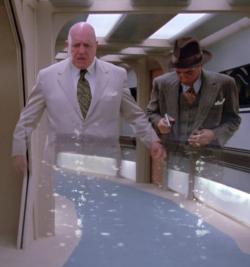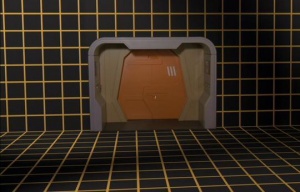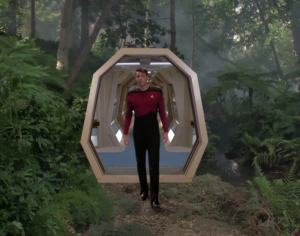Holodeck
A holodeck is a recreational and training room aboard Federation starships and starbases. They are is capable of holographic simulations that both look and feel realistic. Holodecks employ three-dimensional holographic projections as well as replication technology and force field generators to help achieve this realism. The holodeck can also project sounds, smells, and tastes using speakers, atomizers and integral replication systems.
Any program, however small, that can be played inside a holodeck is referred to as a holographic program, or hologram.
A holodeck can generate images that appear to extend for an unlimited distance, making the room appear much larger than it is. In order to do this, the holodeck systems are constantly monitoring the users and adjusting the holographic projections and employing the use if a force-field created treadmill-like device. For example, if a user walks down a long corridor, the simulation changes so they will never run into one of the holodeck's walls.
The holodeck can create solid objects by using replicator technology to create solid matter, such as consumables.
Cleverly, holodeck characters’ programming have been known to include a subroutine element designed to hide anachronisms to the program's time period.
This allows holographic people to ignore such as Starfleet uniforms that would otherwise be out of place, which nd prevents the characters from becoming curious and suspicious.
Holodeck controls exist both inside and outside the room, either by using an arched interface (inside) or a simple control panel embedded in the wall (outside).
By 2364, the Federation and Starfleet were already in the process of installing holodecks aboard most of their vessels.
- Federation holodecks are pre-programmed with safety protocols as so to prevent serious injury to the user or users.
- These safety protocols can be disengaged by the user upon request.
Uses

The widest use for a holodeck on board starships is for entertainment, as crews typically spent months or even years while on missions.
Common holodeck programs include holographic novels, familiar bar or restaurant settings from their homeworld, and watching or participating in sporting events.
Security and Tactical Departments have also been known to employ holodecks for training purposes.
Holodecks can create training simulations as long as someone can think of one, and exercise environments from any known corner of the galaxy, including starship battle simulations.
Design
A typical holodeck is comprised of a holographic grid interface, which contains omnidirectional holographic projectors.
A holodeck also uses elements of transporter technology, replicators, and force fields to make the experience as realistic as possible.
Matter created inside of a holodeck cannot exist outside of a holodeck, and dematerialize quickly without the support of the hologrid.
A holobuffer is used to store complex holograms when they are inactive.
They are also equipped with biofilters, which have to be periodically removed and emptied of waste matter. As removing the filter can momentarily expel a cloud of odorous gas, this task is generally considered highly undesirable.
Interactions
Holographically-created character character are not self-aware, and are not cognizant of the fact that they are not real. However, there are a few rare instances in which this rule is broken: Professor James Moriarty on board the USS Enterprise-D in the 2360s, and eventually, the residents of a fictional town called "Fair Haven" on board the USS Voyager while they were stranded in the Delta Quadrant.
See also:
- Holography
- Hologram
- Holosuite
- Holographic Projector
- Hologenerator
- Mobile emitter
- Isolation suit
- Particle synthesis
- Duck blind

